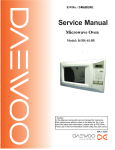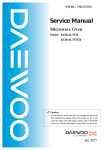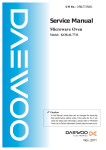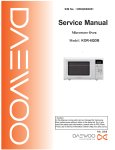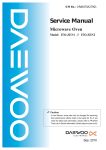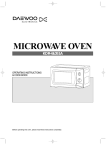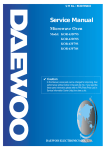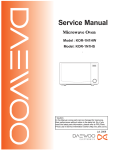Download Daewoo KOR-6L051A Service manual
Transcript
S/M No. : OR6L051001 Service Manual Microwave Oven Model : KOR-6L05 • Caution: In this Manual, some parts can be changed for improving, their performance without notice in the parts list. So, if you need the latest parts information, please refer to PPL(Parts Price List) in Service Information Center (http://svc.dwe.co.kr). Mar. 2003 PRECAUTIONS TO BE OBSERVED BEFORE AND DURING SERVICING TO AVOID POSSIBLE EXPOSURE TO EXCESSIVE MICROWAVE ENERGY (a) Do not operate or allow the oven to be operated with the door open. (b) Make the following safety checks on all ovens to be serviced before activating the magnetron or other microwave source, and make repairs as necessary: (1) Interlock operation, (2) Proper door closing, (3) Seal and sealing surfaces (arcing, wear, and other damage), (4) Damage to or loosening of hinges and latches, (5) Evidence of dropping or abuse. (c) Before turning on power to the microwave oven for any service test or inspection within the microwave generating compartments, check the magnetron, wave guide or transmission line, and cavity for proper alignment, integrity, and connections. (d) Any defective or misadjusted components in the interlock, monitor, door seal, and microwave generation and transmission systems shall be repaired, replaced, or adjusted by procedures described in this manual before the oven is released to the owner. (e) A microwave leakage check to verify compliance with the Federal performance standard should be performed on each oven prior to release to the owner. TABLE OF CONTENTS PRECAUTIONS TO BE OBSERVED BEFORE AND DURING SERVICING TO AVOID POSSIBLE EXPOSURE TO EXCESSIVE MICROWAVE ENERGY ......................................................................................................1 SAFETY AND PRECAUTIONS ...........................................................................................................................................2 1. FOR SAFE OPERATION ..................................................................................................................................2 2. FOR SAFE SERVICE PROCEDURES .............................................................................................................2 SPECIFICATIONS ...............................................................................................................................................................3 EXTERNAL VIEW................................................................................................................................................................4 1. OUTER DIMENSION.........................................................................................................................................4 2. FEATURES DIAGRAM......................................................................................................................................5 INSTALLATION ...................................................................................................................................................................6 OPERATIONS AND FUNCTIONS.......................................................................................................................................7 DISASSEMBLY AND ASSEMBLY......................................................................................................................................8 INTERLOCK MECHANISM AND ADJUSTMENT.............................................................................................................15 TROUBLESHOOTING GUIDE ..........................................................................................................................................16 MEASUREMENT AND TEST ............................................................................................................................................18 1. MEASUREMENT OF THE MICROWAVE POWER OUTPUT ........................................................................18 2. MICROWAVE RADIATION TEST ...................................................................................................................19 3. COMPONENT TEST PROCEDURE ...............................................................................................................20 WIRING DIAGRAM............................................................................................................................................................21 EXPLODED VIEW AND PARTS LIST...............................................................................................................................22 1. DOOR ASSEMBLY .........................................................................................................................................22 2. CONTROL PANEL ASSEMBLY......................................................................................................................22 3. TOTAL ASSEMBLY.........................................................................................................................................22 1 SAFETY AND PRECAUTIONS CAUTION : This Device is to be Serviced Only by Properly Qualified Service Personnel. Consult the Service Manual for Proper Service Procedures to Assure Continued Safety Operation and for Precautions to be Taken to Avoid Possible Exposure to Excessive Microwave Energy. 1. FOR SAFE OPERATION Damage that allows the microwave energy (that cooks or heats the food) to escape will result in poor cooking and may cause serious bodily injury to the operator. IF ANY OF THE FOLLOWING CONDITIONS EXIST, OPERATOR MUST NOT USE THE APPLIANCE. (Only a trained service personnel should make repairs.) (1) A broken door hinge. (2) A broken door viewing screen. (3) A broken front panel, oven cavity. (4) A loosened door lock. (5) A broken door lock. The door gasket plate and oven cavity surface should be kept clean. No grease, soil or spatter should be allowed to build up on these surfaces or inside the oven. DO NOT ATTEMPT TO OPERATE THIS APPLIANCE WITH THE DOOR OPEN. The microwave oven has concealed switches to make sure the power is turned off when the door is opened. Do not attempt to defeat them. DO NOT ATTEMPT TO SERVICE THIS APPLIANCE UNTIL YOU HAVE READ THIS SERVICE MANUAL. 2. FOR SAFE SERVICE PROCEDURES 1. If the oven is operative prior to servicing, a microwave emission check should be performed prior to servicing the oven. 2. If any certified oven unit is found to have excessive emission level 5mW/cm2, the service person should: (a) inform the manufacturer, importer or assembler, (b) repair the unit at no cost to the owner, (c) attempt to ascertain the cause of the excessive leakage, (d) tell the owner of the unit not to use the unit until the oven has been brought into compliance. 3. If the oven operates with the door open, the service person should tell the user not to operate the oven and contact the manufacturer and CDRH immediately. CAUTION MICROWAVE RADIATION PERSONNEL SHOULD NOT BE EXPOSED TO THE MICROWAVE ENERGY WHICH MAY RADIATE FROM THE MAGNETRON OR OTHER MICROWAVE GENERATING DEVICE IF IT IS IMPROPERLY USED OR CONNECTED. ALL INPUT AND OUTPUT MICROWAVE CONNECTIONS. WAVEGUIDES FLANGES AND GASKETS MUST BE SECURED. NEVER OPERATE THE DEVICE WITHOUT A MICROWAVE ENERGY ABSORBING LOAD ATTACHED. NEVER LOOK INTO AN OPEN WAVEGUIDE OR ANTENNA WHILE THE DEVICE IS ENERGIZED. 2 SPECIFICATIONS POWER SUPPLY MICROWAVE 120V AC, 60Hz SINGLE PHASE WITH GROUNDING INPUT POWER 950 W ENERGY OUTPUT 600 W FREQUENCY 2,450MHz OUTSIDE DIMENSIONS (W CAVITY DIMENSIONS (W H H D) D) 17.6 10.6 11.6 8.3 12.8 in 11.9 in CAVITY VOLUME 0.7 cu.ft NET WEIGHT APPROX. 21.0 lbs. TIMER 35min. DUAL SPEED POWER SELECTIONS 5 Levels * Specifications are subject to change without notice. EXTERNAL VIEW 1. OUTER DIMENSION 12.8 10.6 17.6 3 2. FEATURES DIAGRAM 1 2 8 3 7 6 4 9 5 0 q w r e 1 Door latch - When the door is closed, it will automatically shut off. If the door is opened while the oven is operating, the magnetron will automatically shut off. 2 Door seal - The door seal surfaces prevent microwaves escaping from the oven cavity. 3 Oven cavity 4 Control panel 5 Door open button - To open the door push the door open button. 6 Coupler- This fits over the shaft in the center of the oven cavity floor. This is to remain in the oven for all cooking. 7 Roller guide - This must always be used for cooking together with the glass cooking tray. 8 Glass cooking tray - Made of special heat resistant glass. The tray must always be in proper position before operating. Do not cook food directly on the tray. 9 Viewing screen - Allows viewing of food. The screen is designed so that light can pass through, but not the microwave. 0 Waveguide cover - Protects the microwave outlet from splashes of cooking foods. q Safety interlock system w Variable Power Control Knob - Used to select a microwave power level. e Timer knob - Used in setting cooking time for all functions. r Oven lamp - Automatically turns on during oven operating. 5 INSTALLATION 1. Steady, flat location. This microwave oven should be set on a steady, flat surface. 2. Leave space behind and side. All air vents should be kept a clearance. If all vents are covered during operation, the oven may be overheated and, eventually, cause oven failure. 3. Away from radio, and TV sets Poor television reception and radio interference may result if the oven is located close to a TV, radio, antenna, or feeder and so on. Position the oven as far from them as possible. 4. Away from heating appliances and water taps Keep the oven away from hot air, steam or splash when choosing a place to position it, or the insulation might be adversely affected and breakdowns occur. 5. Power supply Check your local power source. This microwave oven requires a current of approximately 12 amperes, 120Volts, 60Hz grounded outlet. 1. A short power-supply cord is provided to reduce the risks resulting from becoming entangled in or tripping over a longer cord. 2. Longer cord sets or extension cords are available and may be used if care is exercised in their use. 3. If a long cord or extension cord is used: 1) The marked electrical rating of the cord set or extension cord should be at least as great as the electrical rating of the appliance. 2) The extension cord must be a grounding type 3-wire cord. 3) The longer cord should be arranged so that it will not drape over the counter top or tabletop where it can be pulled on by children or tripped over unintentionally. 6. Examine the oven after unpacking for any damage such as: A misaligned door, broken door or a dent in cavity. If any of the above are visible, DO NOT INSTALL, and notify a dealer immediately. 6 OPERATIONS AND FUNCTIONS 1. Connect the mains lead to an electrical outlet. 2. After placing the food in a suitable container, open the oven door and put it on the glass tray. The glass tray must always be in place during cooking. 3. Close the door securely. NOTE When setting timer for less than 10 minutes, turn the timer past 10 minutes and then return to the correct timer setting. 4. Choose cooking power level by setting V.P.C knob to the desired position. Refer to cookbook for recommended power levels. 5. Determine cooking time. Consult cookbook for recipe timing. Oven light turns on and cooling fan starts to operate. Microwave cooking starts. 6. You may open the door while the oven is operating. As soon as the door is opened, the safety mechanisms stop the generation of microwave power and the operation of cooking timer. If you wish to change the time during cooking, simply adjust the timer to the desired time. 0 1 min 2 35 3 30 4 25 5 20 15 6 10 9 8 7 7. When the timer reaches zero, a bell will ring and the unit will turn off. Oven light turns off. If additional cooking time is needed and the door is closed, the oven will automatically start when the timer is reset. Make sure the oven is properly installed and plugged into the electrical outlet. Variable power cooking ON and OFF cycle time of mechanical V.P.C switch is 30 seconds. When the V.P.C knob is set to the desired position and timer knob to the desired position, the V.P.C switch has a cycle (ON/OFF time(sec.)) listed below. Variable power setting Approximate Percentage Power level of Power HIGH 100% MEDIUM 77% LOW 55% DEFROST 33% WARM 17% 7 DISASSEMBLY AND ASSEMBLY Cautions to be observed when troubleshooting. Unlike many other appliances, the microwave oven is high-voltage, high-current equipment. It is completely safety during normal operation. However, carelessness in servicing the oven can result in an electric shock or possible danger from a short circuit. You are asked to observe the following precautions carefully. 1. Always remove the power plug from the outlet before servicing. 2. Use an insulated screwdriver and ware rubber gloves when servicing the high voltage side. 3. Discharge the high voltage capacitor before touching any oven components or wiring. (1) Check the grounding. Do not operate on a 2-wire extension cord. The microwave oven is designed to be used with grounded. It is imperative, therefore, to make sure it is grounded properly before beginning repair work. (2) Warning about the electric charge in the high voltage capacitor. For about 30 seconds after the operation stopped and electric charge remains in the high voltage capacitor. When replacing or checking parts, short between oven chassis and the negative high terminal of the high voltage capacitor, by using a properly insulated screwdriver to discharge. 4. When the 12A fuse is blown out due to the operation of the monitor switch; replace primary interlock switch, secondary interlock switch and interlock monitor switch. 5. After repair or replacement of parts, make sure that the screws are properly tightened, and all electrical connections are tightened. 6. Do not operate without cabinet. CAUTION : Service personnel should remove their watches whenever working close to or replacing the magnetron. WARNING : When servicing the appliance, take a care of touching or replacing high potential parts because of electric shock or exposing microwave. These parts are as follows - HV Transformer, Magnetron, HV Capacitor, HV Diode, HV Fuse. 8 1. To remove cabinet 1) Remove four screws on cabinet back. 2) Pull the cabinet backward. 2. To remove door assembly 1) Remove two screws which secure the stopper hinge top. 2) Remove the door assembly from top plate of cavity. 3) Reverse the above for reassembly. NOTE : After replacing the door assembly, perform a check of correct alignment with the hinge and cavity front plate. 9 3. To remove door parts. REF NO. PART CODE PART NAME DESCRIPTION A01 3512210110 FRAME DOOR HIPS SG-970, HG-1760H 1 A02 3517007300 BARRIER-SCREEN *O PET T 0.125 1 A03 3515204120 STOPPER HINGE *T AS KOR-6L0B1A 1 A04 3511706130 DOOR PAINTING AS KOR-6L0B1A 1 A05 3517003700 BARRIER-SCREEN *I POLYESTER T 0.1 1 A06 3512302700 GASKET DOOR PP 1 A07 3513100700 HOOK POM 1 A08 3515101300 SPRING HOOK PW1 1 (1) Remove the gasket door from the door painting assembly. (2) Remove the barrier screen inner from the door painting assembly. (3) Remove the frame door from the door painting assembly. (4) Remove the stopper hinge top assembly from the door painting assembly. (5) Remove the spring hook and the hook from the door painting assembly. (6) Remove the barrier screen outer from the frame door. (7) Reverse the above steps for reassembly. 10 Q’TY REMARK 4. Method to reduce the gap between the door seal and the oven front surface. (1) To reduce gap located on part ‘A’ • Loosen two screws on the stopper hinge top, and then push the door to contact the door seal to the oven front surface. • Tighten two screws. (2) To reduce gap located on part ‘B’ • Loosen two screws on the stopper hinge under, and then push the door to contact the door seal to the oven front surface. • Tighten two screws. (3) To reduce gap located on part ‘C’ • Loosen the screw on the interlock switch assembly located the top of the oven body. • Draw the interlock switch assembly inward as possible to engage with the hook on the door bottom. • Tighten a screw. (4) To reduce gap located on part ‘D’ • Loosen the screw on the interlock switch assembly located the bottom of the oven body. NOTE : A small gap may be acceptable if the microwave leakage does not exceed 4mW/cm2. 11 5. To remove control panel parts. REF NO. PART CODE PART NAME DESCRIPTION Q’TY B01 3513409500 KNOB VPC ABS SG-0760D, SG-175 1 B02 3516735040 CONTROL PANEL ABS VT-0826, AF-348 1 B03 3517402900 COUPLER VPC KNOB POM 1 B04 7122401211 SCREW TAPPING T2S TRS 4X12 MFZN 1 B05 7122401211 SCREW TAPPING T2S TRS 4X12 MFZN 2 B06 3518206440 TIMER VTCB35MFH0 1 B07 3513409400 KNOB ABS SG-0760D, SG-175 1 B08 3513702700 LEVER DOOR OPEN PP 1 B09 441G430171 SPRING BUTTON SWP DIA. 0.7 1 B10 3516915700 BUTTON DOOR OPEN ABS SG-0760D, SG-175 1 1) Remove the screw which secure the control panel, push up two snap fits and draw forward the control panel assembly. 2) Remove two screws which secure the timer assembly. 3) Pull out the timer assembly from the control panel. 4) Pull out the timer knob from the timer. 5) Remove the screw which secure the V.P.C coupler. 6) Pull out the V.P.C coupler and V.P.C knob from the control panel. 7) Reverse the above steps for reassembly. 12 6. To remove high voltage capacitor. 1) Remove the screw which secure the grounding ring terminal of the H.V. diode and the capacitor holder. 2) Remove the H.V. diode from the capacitor holder. 3) Reverse the above steps for reassembly. ◆ High voltage circuit wiring 7. To remove magnetron. 1) Remove three screws which secure the magnetron. 2) Remove the magnetron. 3) Reverse the above steps for reassembly. NOTE : Never install the magnetron without the metallic gasket plate which is packed with each magnetron to prevent microwave leakage. Whenever repair work is carried out on magnetron, check the microwave leakage. It shall not exceed 4mW/cm2 for a fully assembled oven with door normally closed. 13 8. To remove wind guide assembly. 1) Remove the screw for earthing. 2) Remove the noise filter from the wind guide. 3) Remove the screw which secure the wind guide assembly. 4) Draw forward the wind guide assembly. 5) Pull the fan from the motor shaft. 6) Remove two screws which secure the motor shaded pole. 7) Remove the motor shaded pole. 8) Reverse the above steps for reassembly. 9. To remove H.V.transformer. 1) Remove four screws holding the H.V.transformer. 2) Remove the H.V.transformer. 3) Reverse the above steps for reassembly. 14 INTERLOCK MECHANISM AND ADJUSTMENT The door lock mechanism is a device which has been specially designed to completely eliminate microwave radiation when the door is opened during operation, and thus to perfectly prevent the danger resulting from the leakage of microwave. CONDITION : DOOR CLOSED CONDITION : DOOR OPEN (1) Primary interlock switch When the door is closed, the hook locks the oven door. If the door is not closed properly, the oven will not operate. When the door is closed, the hook pushes the button of the microswitch. Then the button of the primary interlock switch bring it under ON condition. (2) Secondary interlock switch and interlock monitor switch When the door is closed, the hook pushes the lock lever downward. The lock lever presses the button of the interlock monitor switch to bring it under NO condition and presses the button of the secondary interlock switch to bring it under ON condition. ADJUSTMENT : Interlock monitor switch When the door is closed, the interlock monitor switch should be "OFF" condition before other switches are "ON" condition. When the door is opened, the interlock monitor switch should be "ON" condition after other switches are "OFF" condition. (3) Adjustment steps a) Loosen the mounting screw. b) Adjust interlock switch assembly position. Actuation distance of primary and secondary interlock switch shall be adjusted almost 0mm. c) Make sure that lock lever moves smoothly after adjustment is completed. d) Tighten completely a mounting screw. NOTE : Microwave emission test should be performed after adjusting interlock mechanism. If the microwave emission exceed 4mW/cm2, readjust interlock mechanism. 15 TROUBLESHOOTING GUIDE Following the procedure below to check if the oven is defective or not. 1. Check grounding before trouble checking. 2. Be careful of the high voltage circuit. 3. Discharge the high voltage capacitor. 4. When checking the continuity of the switches, fuse or high voltage transformer, disconnect one lead wire from these parts and check continuity with the AC plug removed. To do otherwise may result in a false reading or damage to your meter. (TROUBLE 1) Oven does not operate at all ; any inputs can not be accepted. Does the fan motor work when you shut the door and turn the timer? NO Does the fuse blow? YES Check continuity of interlock monitor switch with door shut. NO Continuity Replace primary, secondary interlock switch and interlock monitor switch. NO Replace primary, secondary interlock switch and interlock monitor switch. NO Replace fuse and check continuity of both interlock switch’s contact and monitor switch’s contact with door partially open until monitor switch contact. Both continuity Disconnect one side of the lead wire connected from transformer to the high voltage capacitor, and operate oven. Fuse again If outlet has proper voltage, check continuity of power supply cord. Normal Replace high voltage capacitor. Replace high voltage transformer NO Continuity Replace power supply cord. 16 Does the fan motor work when you shut the door and turn the timer? YES Does the oven lamp light? Does the turntable turn? NO Replace or repair oven lamp, turntable motor. YES Normal reading should be approx. 0 If microwave do not oscillate, check continuity of filament of magnetron. NO Continuity Check continuity filament tap (3.3V) of high voltage. No Continuity Replace high Voltage transformer Continuity Poor continuity Check continuity filament tap (3.3V) of high voltage. Continuity in the reverse direction. Replace high Voltage transformer Continuity Replace magnetron Meter with 6V or higher voltage batteries should be used to check the normal direction resistance of the diode Check the isolation of filament winding of high voltage transformer. NO Continuity Replace high voltage transformer. Good Replace magnetron 17 MEASUREMENT AND TEST 1. MEASUREMENT OF THE MICROWAVE POWER OUTPUT Microwave output power can be checked by indirectly measuring the temperature rise of a certain amount of water exposed to the microwave as directed below. PROCEDURE 1. Microwave power output measurement is made with the microwave oven supplied at rated voltage and operated at its maximum microwave power setting with a load of 1000 5cc of potable water. 2. The water is contained in a cylindrical borosilicate glass vessel having a maximum material thickness of 3 mm and an outside diameter of approximately 190 mm. 3. The oven and the empty vessel are at ambient temperature prior to the start of the test. The initial temperature of the water is 10 2 C (50 3.6 F) It is measured immediately before the water is added to the vessel. After addition of the water to the vessel, the load is immediately placed on the center of the shelf, which is in the lowest normal position. 4. Microwave power is switched on. 5. Heating time should be exactly A seconds. (Refer to table as following) Heating time is measured while the microwave generator is operating at full power. The filament heat-up time for magnetron is not included. 6. The initial and final temperature of water is selected so that the maximum difference between the ambient and final water temperature is 5K. 7. The microwave power output P in watts is calculated from the following formula : P=4187 X T/t T is difference between initial and final temperature. t is the heating time. The power measured should be B (Refer to SPECIFICATIONS)W 10.0%. CAUTION : 1. Water load should be measured exactly to 1 liter. 2. Input power voltage should be exactly specified voltage(Refer to SPECIFICATIONS). 3. Ambient temperature should be 20 2 C(68 3.6 F) Heating time for power output: A(second) 70 64 60 56 52 49 47 44 42 40 38 B(W) 600 650 700 750 800 850 900 950 1000 1050 1100 18 2. MICROWAVE RADIATION TEST CAUTION : 1. Make sure to check the microwave leakage before and after repair of adjustment. 2. Always start measuring of an unknown field to assure safety for operating personnel from microwave energy. 3. Do not place your hands into any suspected microwave radiation field unless the safe density level is known. 4. Care should be taken not to place the eyes in direct line with the source of microwave energy. 5. Slowly approach the unit under test until the radiometer reads an appreciable microwave leakage from the unit under the test. PROCEDURES 1. Prepare Microwave Energy Survey Meter, 600cc glass beaker, and glass thermometer 100 C(212 F). 2. Pour 275cc 15cc of tap water initially at 20 5 C(68 9 F) in the 600cc glass beaker with an inside diameter of approx. 85mm(3.5in.). 3. Place it at the center of the tray and set it in a cavity. 4. Close the door and operate the oven. 5. Measure the leakage by using Microwave Energy Survey Meter with dual ranges, set to 2450MHz. 1) Measured radiation leakage must not exceed the value prescribed below. Leakage for a fully assembled oven with door normally closed must be less than 4mW/cm2. 2) When measuring the leakage, always use the 5cm(2in.) space cone with probe. Hold the probe perpendicular to the cabinet and door. Place the space cone of the probe on the door, cabinet, door seem, door viewing screen, the exhaust air vents and the suction air vents. 3) Measuring should be in a counter-clockwise direction at a rate of 1 in./sec. If the leakage of the cabinet door seem is unknown, move the probe more slowly. 4) When measuring near a corner of the door, keep the probe perpendicular to the areas making sure the probe end at the base of the cone does not get closer than 2 in. from any metal. If it does not, erroneous reading may result. 19 3. COMPONENT TEST PROCEDURE High voltage is present at the high voltage terminal of the high voltage transformer during any cooking cycle. It is neither necessary nor advisable to attempt measurement of the high voltage. Before touching any oven components or wiring, always unplug the oven from its power source and discharge the capacitor. 1. High voltage transformer (1) Remove connections from the transformer terminals and check continuity. (2) Normal readings should be as follows: Secondary winding ...................Approx. 110 10% Filament winding....................................Approx. 0 Primary winding .....................................Approx. 1 2. High voltage capacitor (1) Check continuity of capacitor with meter on the highest OHM scale. (2) A normal capacitor will show continuity for a short time, and then indicate 10M once the capacitor is charged. (3) A shorted capacitor will show continuous continuity. (4) An open capacitor will show constant 10M . (5) Resistance between each terminal and chassis should be infinite. 3. High voltage diode (1) Isolate the diode from the circuit by disconnecting the leads. (2) With the ohmmeter set on the highest resistance scale measure the resistance across the diode terminals. Reverse the meter leads and again observe the resistance reading. Meter with 6V, 9V or higher voltage batteries should be used to check the front-back resistance of the diode, otherwise an infinite resistance may be read in both directions. A normal diode s resistance will be infinite in one direction and several hundred K in the other direction. 4. Magnetron For complete magnetron diagnosis, refer to Measurement of the Microwave Power Output . Continuity checks can only indicate and open filament or a shorted magnetron. To diagnose for an open filament or a shorted magnetron. (1) Isolate magnetron from the circuit by disconnecting the leads. (2) A continuity check across magnetron filament terminals should indicate 0.1 or less. (3) A continuity check between each filament terminal and magnetron case should read open. 5. Fuse If the fuse in the primary and monitor switch circuit is blown when the door is opened, check the primary and monitor switch before replacing the blown fuse. In case the fuse is blown by an improper switch operation, replace the defective switch and fuse at the same time. Replace just the fuse if the switches operate normally. 6. Interlock switches (1) You can test continuity of safety interlock and monitor switch by using ohmmeter. (2) The switch operation is checked by zero/unlimited. The meter should indicate zero resistance. (3) The sequence of check is interlock monitor switch, primary and secondary interlock switches check. 20 S/N : 3513509590 WIRING DIAGRAM 21 EXPLODED VIEW AND PARTS LIST 1. DOOR ASSEMBLY Refer to Disassembly and assembly. 2. CONTROL PANEL ASSEMBLY Refer to Disassembly and assembly. 3. TOTAL ASSEMBLY 22 REF NO. PART CODE A00 3511726250 PART NAME DESCRIPTION DOOR AS KOR-6L0B1A Q'TY 1 B00 3516734170 CONTROL-PANEL AS KOR-6L051A 1 F01 3510808410 CABINET AS KOR-6L0B1A 1 F02 3516117410 CAVITY AS KOR-6L0B1A 1 F03 3516004100 SPECIAL SCREW T1 TRS LR4 POLE 4X10 MFZN 4 F04 7122401211 SCREW TAPPING T2S TRS 4X12 MFZN 1 F05 7112401011 SCREW TAPPING T1 TRS 4*10 MFZN 1 F06 35113NEW55 CORD POWER AS 3X18AWG 70X70 100-RTML 1 F07 3516004100 SPECIAL SCREW T1 TRS LR4 POLE 4X10 MFZN 1 F08 7121300611 SCREW TAPPING T2S PAN 3X6 MFZN 1 F09 3518907200 THERMOSTAT OFF:85 ON:75 H #187 1 F10 3518608310 NOISE-FILTER DWLF-M12 C 1 F11 7121402511 SCREW TAPPING T2S PAN 4X25 MFZN 2 F12 3963822730 MOTOR SHADED POLE 120V 60HZ MW10XA-M02 1 F13 3512527600 GUIDE WIND PP 1 F14 3511800300 FAN PP+30%GLASS 1 F15 3518004300 MAGNETRON RM228HFD 4CF 1 F16 7272400811 SCREW TAPTITE TT3 TRS 4X8 MFZN 3 F17 7S432X4081 SPECIAL SCREW TT3 TRS 4X8 SE MFZN 1 F18 3513003200 HOLDER HV CAPACITOR SECC T0.6 1 F19 3518301301 CAPACITOR HV 2100VAC 0.70UF #187 1 F20 3518400900 DIODE HV AS HVR-1X-30B #187 1 F21 3518122930 TRANS HV DYAR60A0-63T A 1 F22 3516003700 SPECIAL SCREW TT3 HEX 4X8 FLG MFZN 4 F23 3510317500 BASE SBHG T0.5 1 F24 7112401011 SCREW TAPPING T1 TRS 4*10 MFZN 5 F25 3512100900 FOOT PP DASF-130 2 F26 7S432X4081 SPECIAL SCREW TT3 TRS 4X8 SE MFZN 1 F27 3515201101 STOPPER HINGE *U SCP-1 T2.5 1 F28 7112401011 SCREW TAPPING T1 TRS 4*10 MFZN 1 F29 3512527800 GUIDE AIR SECC T0.5 1 F30 3512720220 HARNESS MAIN KOR-6L051A 1 F31 4415A17352 SW MICRO VP-533A-OF SPNO #187 200G 1 F32 4415A66600 SW MICRO VP-532A-OF SPNC #187 200G 1 F33 4415A17352 SW MICRO VP-533A-OF SPNO #187 200G 1 F34 3513702600 LEVER LOCK POM 1 F35 3513818900 LOCK PP FH44D GP-3152F 1 F36 3513601500 LAMP BL 125V 25W T25 C5A H187 1 F37 7112401011 SCREW TAPPING T1 TRS 4*10 MFZN 1 F38 3966821600 MOTOR SYNCRO 120V 60HZ ST-16 KX63MQAD A 1 F39 7272400811 SCREW TAPTITE TT3 TRS 4X8 MFZN 2 F40 3517400620 COUPLER XAREC 1 F41 3511406220 COVER WAVE GUIDE PP J640A WHITE 1 F42 3512517300 GUIDE ROLLER PP 5113MF6 A353B 1 F43 3514700710 ROLLER TEFLON 3 F44 3517203610 TRAY BORO-SI GLASS(NEG) 1 23 DAEWOO ELECTRONICS CORP. 686, AHYEON-DONG MAPO-GU SEOUL, KOREA C.P.O. BOX 8003 SEOUL, KOREA TELEX: DWELEC K28177-8 CABLE: “DAEWOOELEC” S/M NO. : OR6L051001 PRINTED DATE: Mar. 2006
























